Wondershare Filmora (the Latest Filmora version) has the visual audio editing ability to help you edit audio files. In this following guide, you will learn how to:
Adding background music can drastically change the tone of your video. Filmora provides a royalty-free music library you can access within the program, or you can import your own music.
Here are two ways to add background music to your videos:
Note: the music and sound effects found within Filmora are for personal and NON-COMMERCIAL use only. Click here to learn more >>
Import Music from your Computer: Select an audio file that's stored on your PC and bring it into Filmora.
Click the button above the Media Library panel, then browse the audio files on your computer. When you find the song or other audio file you want, select it and import it into the Media Library. You can also drag and drop audio files into the Media Library. From there, you can drag and drop your audio into an Audio Track in the timeline.
button above the Media Library panel, then browse the audio files on your computer. When you find the song or other audio file you want, select it and import it into the Media Library. You can also drag and drop audio files into the Media Library. From there, you can drag and drop your audio into an Audio Track in the timeline.
Using Music from Filmora: choose a song from Filmora’s royalty-free audio library and use it for free. The audio library has 50 songs divided into five categories: YOUNG & BRIGHT, TENDER & SENTIMENTAL, ROCK, FOLK, and ELECTRONIC. There are also sound effects available under SOUND EFFECT.
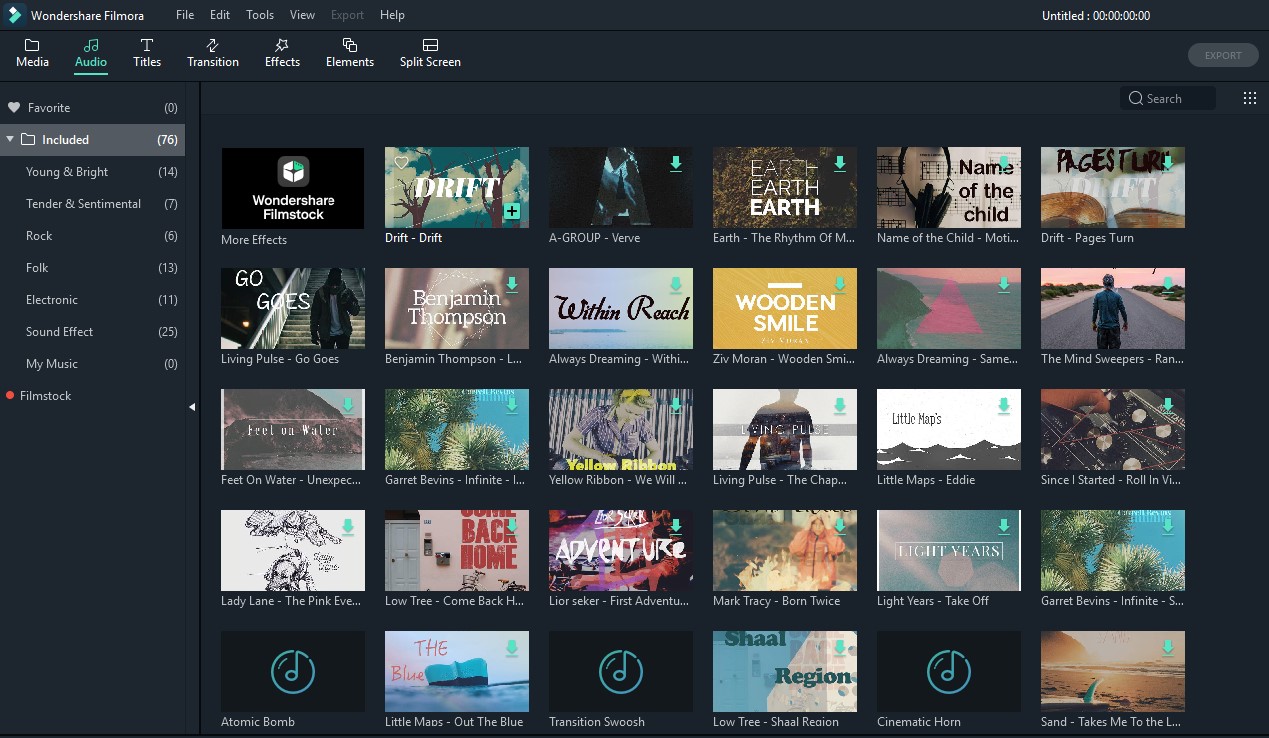
Here are still two ways you can add music from the audio library to your video:
Once you've added your music, double click on the music in the timeline to bring up the Audio window. In this window you can adjust the volume and pitch of the music. You can also make audio keyframing(fade in and fade out) for your music.
Note: you can add up to 100 audio tracks.
Following the beats of music is a great way to make your video more dynamic. Filmora provides a Beat Detection audio tool which marks audio beats automatically, making it easier to match your edit to your music. Here’s how to use Beat Detection:
How to create markers with Beat Detection
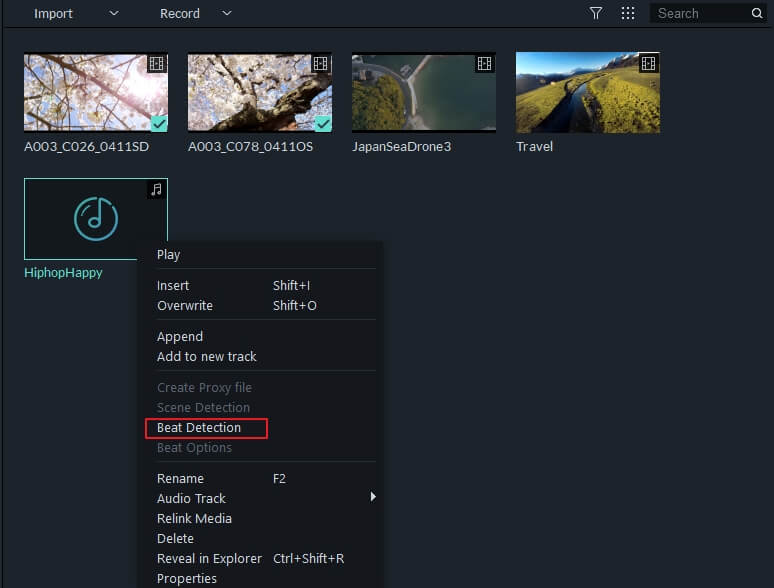
Note: When you use Beat Detection for the first time, it may take some time for Filmora to install the beat detection plugin. When the plugin is installed and the detection is complete, you will see a Beat icon in the lower left corner of your audio clip’s thumbnail like below:
![]()

By default, Filmora will display the generated highlight beat markers in red every four beats. To view beat markers (in blue) for every hit, you can change the beat detection settings by right-clicking the music file in the library and then selecting Beat Options. In the popup window, you can change the highlight beat frequency, highlight offset, or un-check Only mark highlight beats to display every beat marker.


In the timeline, move the playhead to the point in your audio clip where you want to split it. Then, right click on the clip and select "Split" or click the Split button in the toolbar above the timeline.
To make adjustments to your audio, double click on the audio clip you want to work on in the timeline to open a panel with adjustment sliders for volume and pitch. You can also apply Fade in/out effects and adjust their lengths here.
Another tool you’ll find in this panel is Denoise, which is a feature that can remove background noise from your audio clips.
For a more advanced audio editing experience, you can also access the Audio Equalizer from this panel. You can choose from presets or make manual adjustments by clicking ‘Customize’.
Give it a listen when you are done and, if you’re not happy with the results, click Reset to start over.
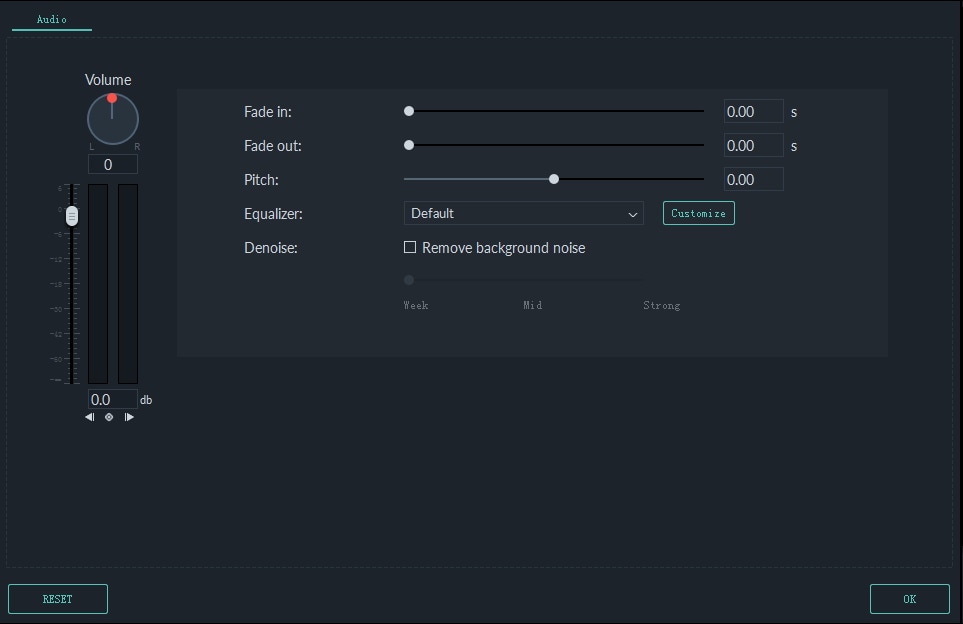
To mute the audio in a video clip, right click on the clip in the timeline and choose Mute.
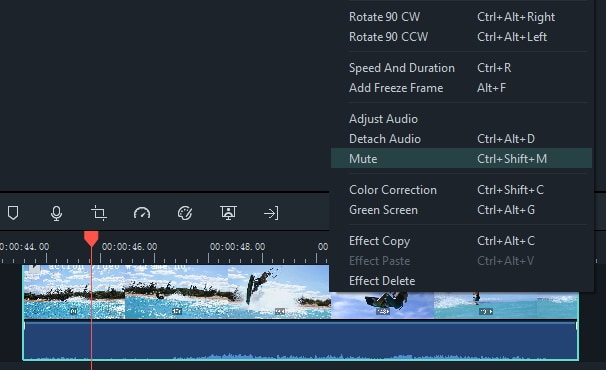
Detach audio from one video:
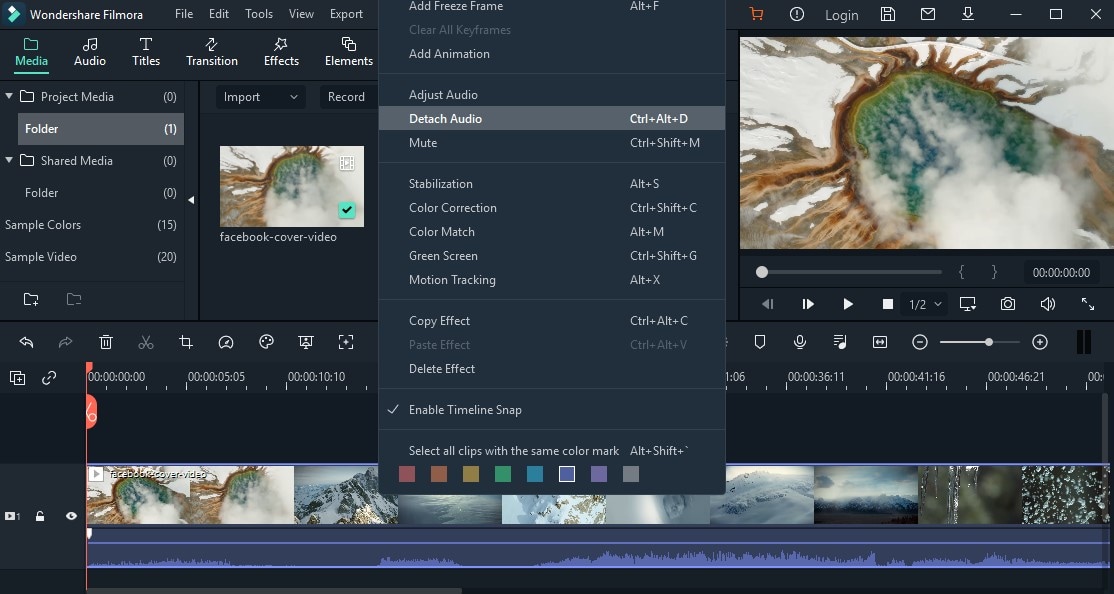

Detach audio from multiple videos:



To remove the original audio and add a new audio clip to a video, please follow the instructions below:
After adding the video clip to the timeline, right-click on it and select Audio Detach. The audio will be detached from the video clip and placed in an audio track.
Import the audio file you want to use from your computer or add music from the Audio library to an audio track. If you are using a higher quality version of the audio which you detached, drag it to an audio track underneath the separated audio and make sure the waveforms line up to sync it. Then, select the detached audio clip and delete it.
To add a voiceover, go to the media panel and select Record Voiceover under Record to bring up the Record Audio window.

Click on ![]() and you will have 3 seconds before the recording starts. Once you are finished recording, click
and you will have 3 seconds before the recording starts. Once you are finished recording, click ![]() . The voiceover clip will automatically appear in the Timeline.
. The voiceover clip will automatically appear in the Timeline.

If you want to record another voiceover, keep the Record Audio window opens. In the timeline, move the playhead to a new position and click on ![]() again to record.
again to record.
Tip: To remove a recorded voiceover, right-click on the voiceover clip in the timeline and choose Delete.
Trimming audio clips works exactly the same as trimming video clips. Click here to learn how.
Adding New Tracks
To add a new video or audio track, click the Plus icon in the left upper corner of the timeline and then select Add Video Track or Add Audio Track. The track will be added.

To add multiple tracks at a time, select Open Track Manager and then enter the number of tracks that you want to add. In the Track Manager panel, you can also customize the placement of the new tracks (i.e. whether they should be before or after an existing track).

Deleting Empty Tracks
To delete empty video and audio tracks, click the Plus icon in the upper left corner of the timeline panel and then select Delete Empty Tracks. All empty video and audio tracks will be deleted.
Adjusting Track Height
Click the Plus icon in the left upper corner of the timeline panel and then select Small, Normal, or Big under Adjust Track Height.

There are several ways to adjust the volume of your audio in Filmora:
To adjust the volume in the Audio panel: after you drag and drop the audio file into the timeline, double click on it to open the Audio panel.
In the volume section, drag the slider up or down to adjust the volume.
To adjust the volume in the timeline: Move your mouse over the volume band in the audio clip and the pointer will change to a hand icon  .
.
Drag the handle up to increase the volume and drag it down to decrease the volume.
If you want to adjust the left/right balance, enter a numerical value or drag the knob in the Balance circle. A numerical value of 0 means the audio is balanced, -100 is all the way to the left, and 100 is all the way to the right.

If you need to have the volume increase and decrease as the clip plays, use audio keyframes.
To add an audio keyframe, go to the timeline and move the playhead to the location where you want the change in volume to start.
Double click the audio clip to open the Audio control panel and click the keyframe button.

Next, move the playhead to where you want the volume adjustment to end and click the Keyframe button again. Now you’ll be able to rag the volume envelope (the line between your two keyframe dots) to adjust the volume of that section of your audio clip.

After adding your audio to the timeline, double click on it to open the Audio adjustment panel.
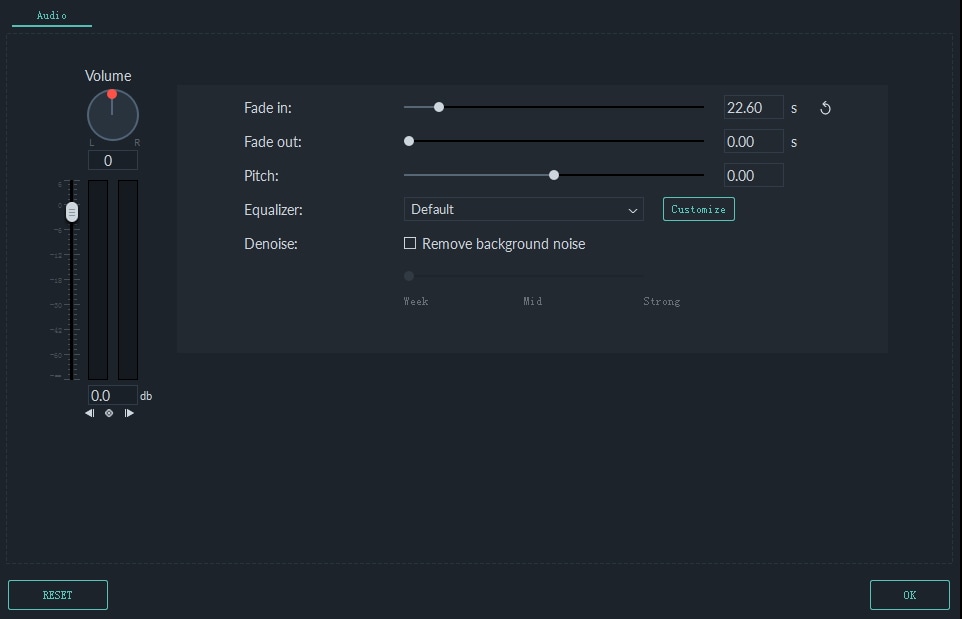
Set fade in and fade out effects by dragging the sliders or by entering how many seconds a fade effect should last.
You can also use the fade icons at the left and right edges of the audio waveform areas to quickly fade in and out.
At the beginning of the audio clip, drag the fade in maker to the right to apply a fade-in effect.
To apply a fade-out effect, go to the end of the audio clip and drag the fade-out maker to the left.
The further you drag, the longer the fade effect will last.
Adjusting the speed of your audio works the same as adjusting video speed:
Right-click on the audio file and select Speed and Duration.
You could also select the audio clip in the timeline and click the Speed icon in the toolbar.
To remove unwanted background noise from your recorded audio, follow the steps below:
Double click on an audio clip in the timeline panel to open the Audio adjustment window.
Check the box next to Remove background noise.
Drag the slider to the level (Weak, Mid, or Strong) of noise reduction that you need.
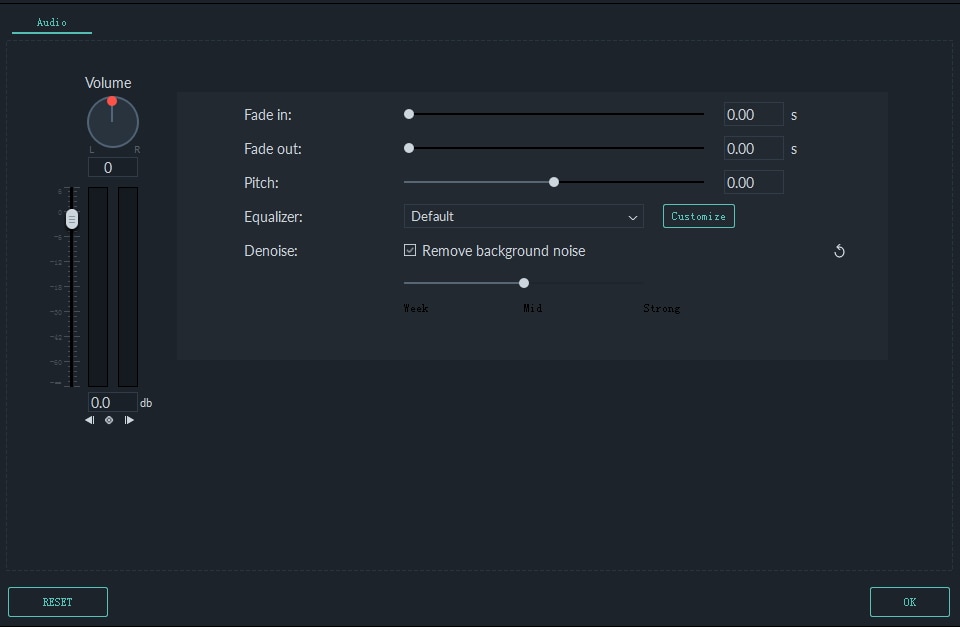
To remove background noise from a video clip, double click on the video clip in the timeline to open the video adjustment panel. Go to the Audio tab and then follow the above steps.

Note: The types of noise you can remove using the denoise tool include wind noise, computer hums, and other consistent sounds.
The Audio Equalizer (EQ) enables you to raise and lower the loudness of an audio frequency (i.e. bass or treble). Here’s how it works:
Double click the video or audio file in the timeline and then go to the Audio tab.
You can select presets in the Equalizer dropdown list, including Default, Classic, Low Bass, Sparkle, Pop, Rock' n' Roll, Soft, Techno, Hard Rock, Ska, Country, Acoustic, Folk, Blues, and Custom. Or, you can click the Customize button and access the Custom Equalizer window to adjust the gain by dragging the sliders up or down.

Click the OK button to save your adjustments.
You can use the Audio Mixer to fine-tune the audio of your projects. To use the Audio Mixer, please follow these instructions:
Select the audio mixer icon ![]() in the toolbar to open the Audio Mixer panel.
in the toolbar to open the Audio Mixer panel.
You can switch the sound between left and right by dragging the knob in the Pan/Balance control. You can see your changes clearly in the channel control panel to the right.
There are two modes: Stereo and Surround. In Surround mode, you can pan from left to right as well as front to back, which gives you full control of the audio position in Surround sound mode.

While in Stereo mode, you can only pan left or right.

You can also go to the master section and drag the Master volume slider upward or downward to adjust the master volume higher or lower. After you’ve made adjustments, click the Play button to hear the results.
Select OK to save the settings.
Audio ducking means lowering the volume of things like background music in order for your dialogue to be heard more clearly. Here’s how to apply it:
1. Select the clip or clips you want to apply audio ducking to (you’ll be selecting the clips you want to hear more clearly, not the ones you want to lower the volume on).
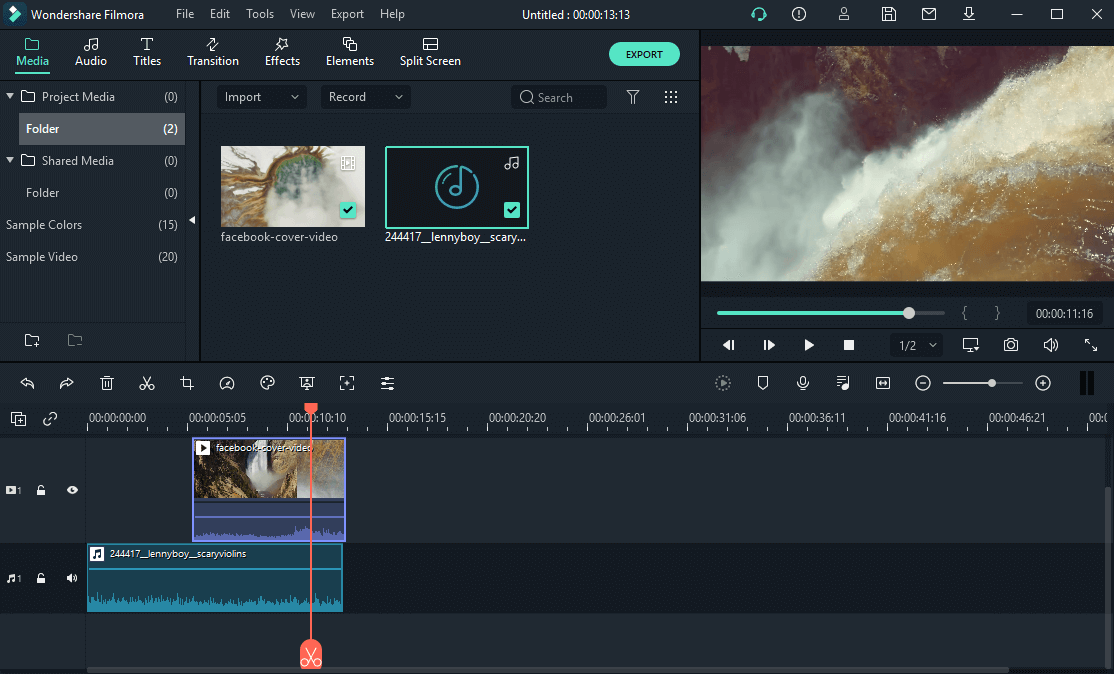
2. Right-click and choose Adjust Audio.

3. Check the box next to lower the volume of other clips. A slider will appear which you can use to adjust how much the volume is lowered.
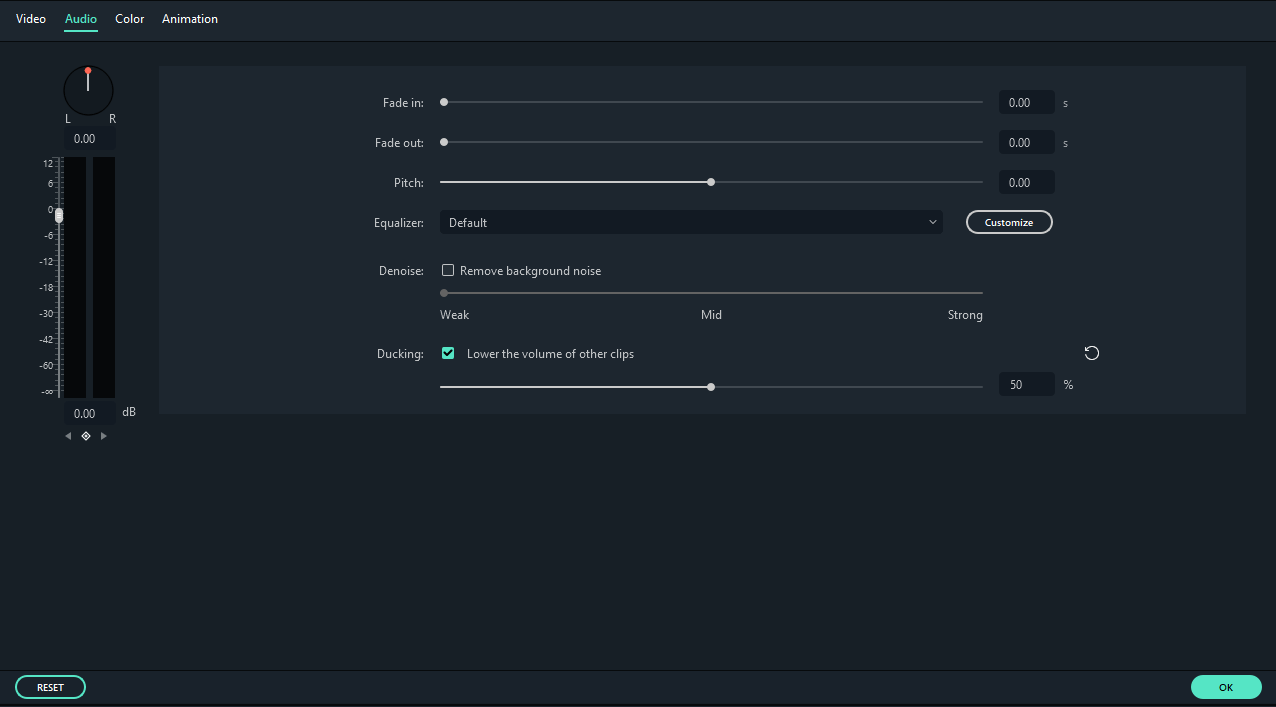
Besides the free built-in royalty-free music and sound effects, Filmora integrates the free and standard sound effects from Wondershare Filmstock (Effects Store). Now you can find hundreds of sound effects and easily search the sound effects you want, and add them to your video.
To add sound effects to your video follow the steps below:
1. Import your video to Filmora, then drag and drop it to the timeline.

2. Search the sound effect you want in the search bar under the Audio tab (or you can explore the audio categories and find the sound effect you want), and add it to the video directly.
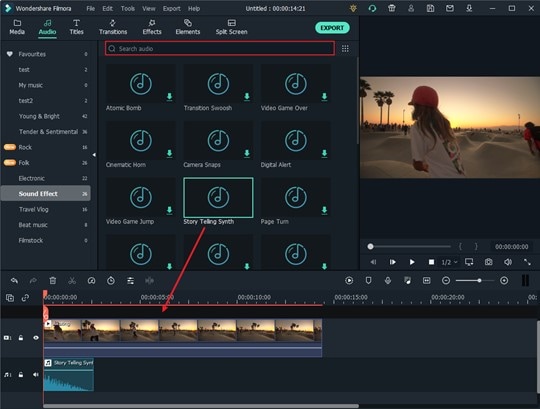
Note: When you apply the sound effects to the video, it may take several seconds to download and load them.
You can apply the audio effect presets included in Filmora to both audio and video clips, simulating the sound in different environments, and enhancing your video’s sound.

Currently, you can adjust the settings of echo, lobby, big room, and small room audio effects.
To adjust the audio effects applied, double click the timeline clip and then go to Audio Effects under the Audio tab.
Settings for Echo Audio Effects:
Filmora provides 2 settings to adjust audio effects:
1. Delay Time: Indicates the delay between each echo in seconds. You can choose 0-2 seconds between each delay.
2. Decay Factor: adjust the factors that impact the audio decay effect. 0 means no echo, and 1 means that each echo is as loud as the original. A smaller value means the echo effect will die out quickly.
Note: The Echo audio effect will not extend the duration of the clip, so you may need some silence to end of the track.

Settings for Lobby, Large Room, and Small Room Audio Effects
Filmora provides reverb settings to adjust the Lobby, Large Room and Small Room audio effects.
You can adjust the reverb settings between 0 and 10, the large the number, the stronger the reverb, and vice versa for smaller size.

Replace Audio Effect
To replace the applied audio effect, just drag and drop audio effects to the video clip in the timeline, and click OK in the pop-up window as shown below.

Remove Applied Audio Effects
To remove applied audio effects, click the clip containing the effect in the timeline, go to the Audio tab, scroll down to the Audio Effect field and uncheck it.

The applied audio effects will be removed automatically, and the audio effect icon in the timeline will turn to grey.
Or, you can click the X icon next to the Audio Effect to delete it.
![]()
Note: If you want to remove all applied effects from the clip, right click it in the timeline, and select Delete Effect. The applied audio effects and other video effects such as filters or overlays will be removed altogether.
